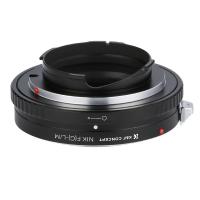What Is An Optical Microscope ?
An optical microscope is a type of microscope that uses visible light and a series of lenses to magnify and observe small objects or specimens. It is also known as a light microscope. The specimen is placed on a glass slide and illuminated from below with a light source. The light passes through the specimen and is magnified by a series of lenses, which produce an enlarged image that can be viewed through the eyepiece. Optical microscopes are commonly used in biology, medicine, and materials science to study the structure and properties of cells, tissues, and materials at the microscopic level. They are relatively inexpensive and easy to use, making them a popular tool for scientific research and education.
1、 Definition and History of Optical Microscopes

What is an optical microscope?
An optical microscope is a type of microscope that uses visible light and a series of lenses to magnify small objects. It is one of the most commonly used types of microscopes in biology, medicine, and materials science. Optical microscopes can magnify objects up to 1000 times their original size, allowing scientists to study the structure and behavior of cells, tissues, and other small structures.
Definition and History of Optical Microscopes:
The optical microscope was first invented in the late 16th century by Dutch spectacle makers Hans Lippershey and Zacharias Janssen. The first microscopes were simple, handheld devices that used a single lens to magnify objects. Over time, scientists developed more complex microscopes with multiple lenses and better magnification capabilities.
Today, optical microscopes come in a variety of designs, including compound microscopes, stereo microscopes, and digital microscopes. They are used in a wide range of scientific fields, from biology and medicine to materials science and engineering.
The latest point of view on optical microscopes is that they continue to be an essential tool for scientific research, despite the development of newer technologies such as electron microscopes and atomic force microscopes. Optical microscopes are relatively inexpensive, easy to use, and can provide high-resolution images of biological and materials samples. Additionally, advances in imaging techniques such as confocal microscopy and super-resolution microscopy have further expanded the capabilities of optical microscopes, allowing scientists to study complex biological processes and materials at the nanoscale level.
2、 Parts and Components of an Optical Microscope

What is an optical microscope?
An optical microscope is a type of microscope that uses visible light and a series of lenses to magnify small objects. It is one of the most commonly used types of microscopes in scientific research and education. The basic design of an optical microscope consists of an objective lens, an eyepiece, and a light source. The objective lens is used to magnify the specimen, while the eyepiece is used to view the magnified image. The light source illuminates the specimen, making it visible to the observer.
Parts and Components of an Optical Microscope:
1. Objective lens: This is the primary lens of the microscope and is responsible for magnifying the specimen.
2. Eyepiece: This is the lens that the observer looks through to view the magnified image.
3. Stage: This is the platform on which the specimen is placed for observation.
4. Light source: This provides the illumination necessary to view the specimen.
5. Diaphragm: This controls the amount of light that reaches the specimen.
6. Focus knobs: These are used to adjust the focus of the microscope.
7. Body tube: This connects the objective lens to the eyepiece.
8. Arm: This supports the body tube and provides a handle for carrying the microscope.
9. Base: This provides stability for the microscope.
In recent years, there have been advancements in optical microscopy, such as confocal microscopy and super-resolution microscopy, which have allowed for even higher magnification and resolution of specimens. These advancements have greatly expanded the capabilities of optical microscopy in various fields of research, including biology, medicine, and materials science.
3、 Types of Optical Microscopes (e.g. Compound, Stereo, Digital)

An optical microscope is a scientific instrument that uses visible light and lenses to magnify small objects or specimens. It is one of the most commonly used tools in biology, medicine, and materials science. The basic design of an optical microscope consists of an objective lens, an eyepiece, and a light source. The objective lens is used to magnify the specimen, while the eyepiece is used to view the magnified image. The light source illuminates the specimen, making it visible to the observer.
There are several types of optical microscopes, including compound microscopes, stereo microscopes, and digital microscopes. Compound microscopes are the most common type and are used to view thin, transparent specimens such as cells, bacteria, and tissue samples. Stereo microscopes, also known as dissecting microscopes, are used to view larger, opaque specimens such as insects, rocks, and circuit boards. Digital microscopes use a camera to capture images of the specimen and display them on a computer screen.
In recent years, there have been significant advancements in optical microscopy technology. Super-resolution microscopy techniques, such as stimulated emission depletion (STED) microscopy and structured illumination microscopy (SIM), have allowed researchers to view structures at the nanoscale level. Additionally, confocal microscopy has become a popular technique for imaging thick specimens, such as tissue samples, by using a laser to scan through the sample and create a 3D image.
Overall, optical microscopes continue to be an essential tool in scientific research and are constantly evolving to meet the needs of researchers in various fields.
4、 Principles of Optical Microscopy (e.g. Magnification, Resolution)

An optical microscope is a type of microscope that uses visible light and lenses to magnify and observe small objects or specimens. It is one of the most commonly used types of microscopes in biology, medicine, and materials science. The basic principle of an optical microscope is to use lenses to focus light onto a specimen and then magnify the image formed by the light passing through the specimen.
The magnification of an optical microscope is determined by the combination of the objective lens and the eyepiece. The objective lens is the lens closest to the specimen and provides the primary magnification, while the eyepiece further magnifies the image formed by the objective lens. The resolution of an optical microscope is determined by the wavelength of the light used and the numerical aperture of the objective lens. The numerical aperture is a measure of the lens's ability to gather light and is determined by the lens's design and the refractive index of the medium between the lens and the specimen.
Recent advances in optical microscopy have led to the development of new techniques such as confocal microscopy, super-resolution microscopy, and multiphoton microscopy. These techniques have greatly improved the resolution and imaging capabilities of optical microscopes, allowing researchers to observe and study biological and materials systems at the nanoscale level. Additionally, the use of fluorescent dyes and probes has enabled the visualization of specific molecules and structures within cells and tissues, providing new insights into cellular processes and disease mechanisms.







































